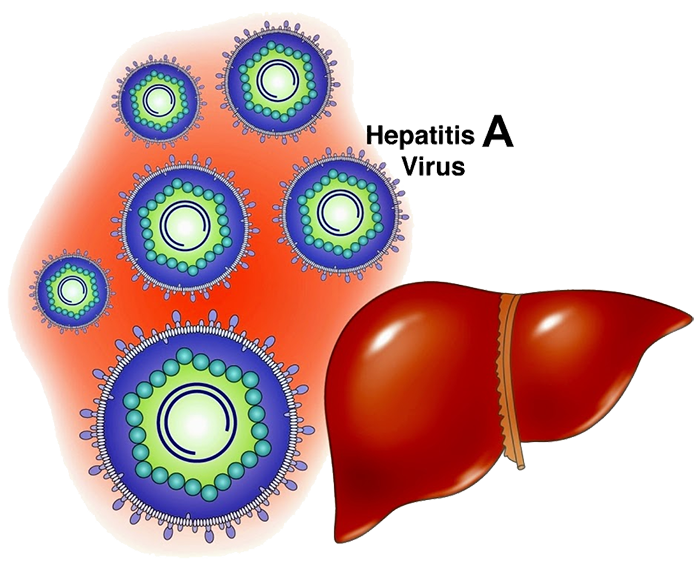BACKGROUND
Hepatitis A is a liver disease caused by the hepatitis A virus. The virus is primarily spread when an uninfected (and unvaccinated) person ingests food or water that is contaminated with the faeces of an infected person.
The disease is closely associated with unsafe water, inadequate sanitation and poor personal hygiene.
DISEASE OCCURRENCE IN POPULATION
Hepatitis A Virus has a worldwide distribution, particularly in resource-poor regions. Globally, an estimated 1.4 million cases occur each year.

Between 1995 and 2006, the reported hepatitis A incidence declined by 90% to the lowest rate ever recorded, 1.2 cases per 100,000 population. The greatest reductions were seen in children and in those regions where routine vaccination of children is observed.
The highest seropositivity (i.e. the highest prevalence of antibody to HAV) is observed in adults in urban Africa, Asia, and South America, where evidence of past infection is nearly universal.
TRANSMISSION
Hepatitis A virus is usually transmitted via the fecal-oral route, either via person-to-person contact or consumption of contaminated food or water
Person-to-person contact
- Transmission within households
- Sexual transmission
- Residential institution transmission
- Daycare center transmission
- Transmission among military personnel
Contact with contaminated food or water
- Consumption of raw or undercooked shellfish, vegetables, or other foods
- Consumption of foods contaminated by infected food handlers
- Blood transfusion
- Illicit drug use
RISK FACTORS
Most patients have no defined risk factors for hepatitis A. Risk factors for the acquisition of hepatitis A may include the following:
- Poor sanitation
- Lack of reliable clean water resource
- Overcrowding
- Personal contacts
- Institutionalization
- Occupation (e.g. daycare)
- Foreign travel
- Male homosexuality
- Illicit parenteral drug use
SIGN AND SYMPTOMS
- Mild flu-like symptoms
- Anorexia,
- Nausea and vomiting,
- Fatigue,
- Malaise,
- Low-grade fever (usually < 39.5°C),
- Myalgia,
- Mild headache
- Pale stools
- Pruritis
- Jaundice
- Hepatomegaly
DIAGNOSTIC TESTS
A person is diagnosed with hepatitis A virus based upon their signs or symptoms, a physical examination, and blood testing. The blood test becomes positive about five days before symptoms appear and remains positive for about six months after infection.
TREATMENT OPTIONS
As no specific treatment exists for hepatitis A, prevention is the most effective approach against the disease.
Immunization
Vaccination is highly effective in preventing HAV disease. The efficacy of the hepatitis A vaccine ranges from 80% to 100% after 1-2 doses compared to placebo.
Supportive Care
For acute cases of HAV infection, therapy is generally supportive, with no specific treatment of acute uncomplicated illness. Locating the primary source and preventing further outbreaks are paramount. Initial therapy often consists of bed rest. The patient should probably not work during the acute phase of the illness.
Antiemetic:
Nausea and vomiting are treated with antiemetics.
Hand hygiene:
Hand washing is an essential and effective way to prevent the spread of infection. Hands should ideally be wet with water and plain or antimicrobial soap and rubbed together for 15 to 30 seconds. Special attention should be paid to the fingernails, between the fingers, and the wrists. Hands should be rinsed thoroughly and dried with a single-use towel.
It is not clear if alcohol-based hand rubs are effective against hepatitis A virus. For this reason, food handlers, daycare providers, travelers, and anyone else who is at risk of transmitting or becoming infected with HAV is advised to wash their hands with soap and water when possible. Alcohol-based hand rubs are a reasonable alternative if a sink is not available.
Hands should be cleaned after changing a diaper or touching any soiled item. They should also be washed before and after preparing food and eating, after going to the bathroom, and after handling garbage or dirty laundry.
Intravenous fluid:
Dehydration may be managed with hospital admission and intravenous (IV) fluids. The majority of children have minimal symptoms; adults are more likely to require more intensive care, including hospitalization.
Antiviral agents:
The advent of new antiviral agents, such as direct-acting antivirals (DAAs) and host-targeting agents (HTAs) has expanded the potential therapeutic options available against HAV.
Acetaminophen:
Pain control is essential to quality patient care. Acetaminophen is useful for pain and/or fever.
Liver Transplantation
Patients with fulminant hepatic failure (FHF) are considered for liver transplantation. Recurrent disease after liver transplantation has not been reported.
PRECAUTIONS
Hepatitis A virus infection is preventable with several strategies, discussed below. Hand washing is one of the most effective strategies for reducing transmission since the virus can live on the fingers for up to four hours.
Hand hygiene:
Hand washing is an essential and effective way to prevent the spread of infection. Hands should ideally be wet with water and plain or antimicrobial soap and rubbed together for 15 to 30 seconds. Special attention should be paid to the fingernails, between the fingers, and the wrists. Hands should be rinsed thoroughly and dried with a single-use towel.
It is not clear if alcohol-based hand rubs are effective against hepatitis A virus. For this reason, food handlers, daycare providers, travelers, and anyone else who is at risk of transmitting or becoming infected with HAV is advised to wash their hands with soap and water when possible. Alcohol-based hand rubs are a reasonable alternative if a sink is not available.
Hands should be cleaned after changing a diaper or touching any soiled item. They should also be washed before and after preparing food and eating, after going to the bathroom, and after handling garbage or dirty laundry.
Safe food preparation:
Taking precautions when preparing foods can reduce the risk of becoming ill. The following precautions have been recommended by the Food Safety and Inspection Services and the United States Centers for Disease Control and Prevention.
- Do not drink raw (unpasteurized) milk or foods that contain unpasteurized milk.
- Wash raw fruits and vegetables thoroughly before eating.
- Keep the refrigerator temperature at 40oF (4.4oC) or lower; the freezer at 0oF (-17.8oC) or lower.
- Use precooked, perishable, or ready-to-eat food as soon as possible.
- Keep raw meat, fish, and poultry separate from other food.
- Wash hands, knives, and cutting boards after handling uncooked food, including produce and raw meat, fish, or poultry.
- Thoroughly cook raw food from animal sources to a safe internal temperature: ground beef 160oF (71oC); chicken 170oF (77oC); turkey 180oF (82oC); pork 160oF (71oC).
- Cook chicken eggs thoroughly, until the yolk is firm.
- Refrigerate foods promptly. Never leave cooked foods at room temperature for more than two hours (one hour if the room temperature is above 90oF/32oC).
People who are preparing to travel to areas where HAV infections commonly occur should take precautions when eating and drinking to avoid becoming ill.
Hepatitis A vaccination:
Hepatitis A vaccination is available in Pakistan. Hepatitis A vaccine is recommended for all children between 12 and 23 months of age and those ages 2 to 18 who live in states or communities of high disease incidence.
The most common side effect of the hepatitis A virus vaccine is brief redness or discomfort at the injection site.
The hepatitis A virus vaccine is recommended for all at-risk adults, including:
- Travelers to countries where hepatitis A virus is common; the vaccine can be given at any time before traveling
- Injection and non-injection illegal drug users
- Men who have sex with men
- People with chronic liver disease
- Adults with blood clotting factor disorders
- Adults who are at risk for infection at work, including daycare center staff, personnel in healthcare facilities (e.g. nursing homes), and food handlers
Immune globulin:
Individuals who are at risk for hepatitis A but who are allergic to components of the hepatitis A vaccine or who prefer not to receive the vaccine should consider taking a dose of immune globulin.
Immune globulin is an injection that provides temporary protection against hepatitis A and reduces the risk of infection by more than 90 percent. However, the hepatitis A vaccine is preferred to immune globulin in most cases because it provides long-lasting protection and because immune globulin is not always available.
REFERENCES
Domínguez A, Bruguera M, Plans P, et al.
Declining hepatitis A seroprevalence in adults in Catalonia (Spain):
a population-based study. BMC Infect Dis. 2007. 7:73.
Kanyenda TJ, Abdullahi LH, Hussey GD, Kagina BM.
Epidemiology of hepatitis A virus in Africa among persons aged 1-10 years:
a systematic review protocol. Syst Rev. 2015 Sep 26. 4:129.
Chobe LP, Arankalle VA.
Investigation of a hepatitis A outbreak from Shimla Himachal Pradesh.
Indian J Med Res. 2009 Aug. 130(2):179-84.
Kamath SR, Sathiyasekaran M, Raja TE, Sudha L.
Profile of viral hepatitis A in Chennai.
Indian Pediatr. 2009 Jul. 46(7):642-3.
Kodani M, Mixson-Hayden T, Drobeniuc J, Kamili S.
Rapid and sensitive approach to simultaneous detection of genomes of hepatitis A, B, C, D and E viruses.
J Clin Virol. 2014 Oct. 61 (2):260-4.
Mbithi JN, Springthorpe VS, Boulet JR, Sattar SA.
Survival of hepatitis A virus on human hands and its transfer on contact with animate and inanimate surfaces.
J Clin Microbiol 1992; 30:757
Ansaldi F, Bruzzone B, Rota MC, et al.
Hepatitis A incidence and hospital-based seroprevalence in Italy:
a nation-wide study. Eur J Epidemiol. 2008. 23(1):45-53.
Aggarwal R, Goel A. Hepatitis A:
epidemiology in resource-poor countries.
Curr Opin Infect Dis. 2015 Oct. 28 (5):488-96.
Wasley A, Grytdal S, Gallagher K,.
Surveillance for acute viral hepatitis--United States, 2006.
MMWR Surveill Summ. 2008 Mar 21. 57(2):1-24.
Cao J, Wang Y, Song H, Meng Q, Sheng L, Bian T, et al.
Hepatitis A outbreaks in China during 2006:
application of molecular epidemiology. Hepatol Int. 2009 Jun. 3(2):356-63.
Fischer GE, Thompson N, Chaves SS, Bower W, Goldstein S, Armstrong G, et al.
The epidemiology of hepatitis A virus infections in four Pacific Island nations, 1995-2008.
Trans R Soc Trop Med Hyg. 2009 Sep. 103(9):906-10.
Amin J, Gilbert GL, Escott RG, et al.
Hepatitis A epidemiology in Australia:
national seroprevalence and notifications. Med J Aust. 2001 Apr 2. 174(7):338-41
Centers for Disease Control and Prevention.
Hepatitis A Questions and Answers for Health Professionals.
(Accessed on November 16, 2018).
